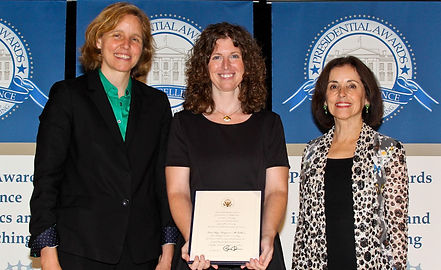
My classroom has transformed over the last year and a half in response to what I have learned in the masters of education program at UNE. My teaching has always had passion and I had some good ideas, but without an understanding of current educational theories and best practices, my chosen strategies were hit or miss. My units lacked a clearly defined purpose. My studies at UNE have given me a framework for creating well-designed units and tools for finding the best strategies to meet the needs of my learners. Additionally, this program has provided guided practice in trying new methods and reflecting upon their degree of success.
While I knew I had to make activities fun and interesting, in the UNE program I learned to use a variety of strategies to motivate students. For example, my classroom is built around the concept of a learning community. My students are invested in the value of everyone working together to learn. Students work on teams and help each other. They are role models and spontaneous teachers. Making use of social cognitive theory, students are motivated to engage in learning activities when they see peers doing those activities (Anderman & Anderman, 2014). Another method I employ to motivate students is through “providing feedback and giving opportunities for remediation” (Anderman & Anderman, 2014, p. 84). This practice reinforces a mastery goal mindset and helps students care about learning for the sake of learning rather than for extrinsic motivators (Anderman & Anderman, 2014). The building of this learning community has also produced benefits for classroom management. Students are trained in managing their learning, including classroom resources and materials, and students are taught procedures for the learning tasks and transitions, so after the first few weeks of school, less time is spent on classroom management. The learning community helps students support one another in making good choices. Classroom management is easier to accomplish by designing activities that are motivating, creating a supportive learning environment and culture of mutual respect than by relying on systems of rewards and punishments.
My area of greatest interest is instructional strategies and curriculum design. Learning about differentiation helped elevate my classroom from offering some different learning tasks to having a variety of activities that represent a range of learning styles and meet the needs of diverse learners. I have shifted away from a teacher-centered classroom to one in which students have choice each day and multiple pathways to clearly defined learning targets. By reading Tomlinson & McTighe (2006), I learned how to make the learning goals clear to students so they have the tools to select appropriate learning activities and to track their progress toward curricular goals. The students’ use of self-reflection added a layer of assessment data to my class which enhanced my ability to meet my students’ learning needs. One of the things I learned that had the most significant impact on my teaching practice was Universal Design for Learning. I have been able to restructure my teaching materials with this lens, creating more purposefully designed units and lessons that avoid obstacles and barriers to learning. This way of thinking about my classroom had led me to a profound response to students’ requests. “Yes!” Rigid ideas about how one must interact with the content or how one must demonstrate understanding creates obstacles. With clear learning targets, it has become easy to encourage students to do things their way (Rose, 2010). By honoring students' requests to learn or demonstrate understanding in another way, I empower them as learners and encourage them to use their strengths to be active participants in the learning community.
The online masters of education program at UNE has helped me grow as an educator. I have developed lifelong learning skills that will continue to enable me to access new strategies and ideas to meet the changing needs of my students and the growing access to technologies. Through this program I have learned the value of peer interaction, feedback, and reflection around our work. The skills and attitudes cultured in this program have helped me move into positions of teacher leadership and have broadened my view of my role in the education community. For one of my last assignments, I read a vision statement I had written as a pre-service teacher. I had many good ideas about what a classroom should be, but I did not know how to make it happen. Now at the end of this UNE program, I know I can reach those goals.
References:
Anderman, E. M., & Anderman, L. H. (2014). Classroom motivation. Boston: Pearson Education.
Rose, D. (2010). UDL: Principles and Practice. Retrieved December 04, 2016, from http://www.youtube.com/watch?v=pGLTJw0GSxk
Tomlinson, C. A., & McTighe, J. (2006). Integrating differentiated instruction & understanding by design: Connecting content and kids. Alexandria, VA: Association for Supervision and Curriculum Development.

Lisa McLellan, Awardee, holding Presidential certificate between Megan Smith, U.S. Chief Technology Officer and Director of the National Science Foundation, Dr. France A. Còrdova.

Experiential learning science trip to Ecuador: field experiences gives students opportunities to learn and practice skills first hand in authentic situations

Paintball with the AP Chemistry class: building relationships by working and playing together creates a community of learners who help one another, respect one another, and value a collective learning experience.
